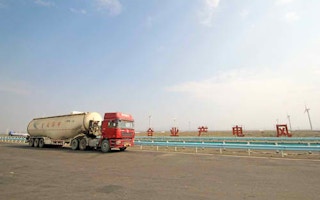China’s One Belt, One Road initiative, which aims to further the country’s influence and trade links with almost 60 countries, mainly in Asia and Europe, could be a major source of environmental damage unless projects are backed by green banking, experts have told chinadialogue.
Under OBOR, over the next few decades China plans to build a land-based Silk Road Economic Belt and a 21st Century Maritime Silk Road. The much-hyped initiative involves massive use of concrete, steel, chemicals, and base metals. Hundreds of thousands of workers and huge use of transport will be also needed to build new power stations, mines, energy projects, roads, railways, airports and container ports.
Much of the construction, which would be among the biggest foreign-funded building booms in history, would occur in countries where environmental oversight is deemed to be flimsy, stoking fears of huge environmental damage.
China and the countries eyed up for OBOR projects between them account for over half of the world’s greenhouse gas emissions, according to the China Academy of Sciences.
Xu Qinghua, deputy secretary of the China Council for International Cooperation on Environmental and Development, says swift action is needed to avoid environmentally-damaging investments that would be ‘locked in’ for decades.
“Promotion of green development in the region not only requires effective environmental control and treatment measures, but also requires financing at an early stage that favours greener projects,” he said.
According to estimates, the OBOR initiative will add a US$2.5 trillion (16.5 trillion yuan) to China’s trade in the next decade, while auditing firm PWC reckons that more than US$250 billion worth of projects had been commissioned by the middle of last year.
In the views of some experts, China needs to implement responsible lending criteria that banks would be encouraged to follow.
“
Promotion of green development in the region not only requires effective environmental control and treatment measures, but also requires financing at an early stage that favours greener projects.
Xu Qinghua, deputy secretary of the China Council for International Cooperation on Environmental and Development
Last year, WWF China and the China-ASEAN Environmental Cooperation Centre discussed findings that China lacks clear environmental rules and oversight for its firms working overseas.
Given the varying capabilities of countries covered by OBOR, the report recommended that China encourage transparency on information on social and environmental risks, and compel Chinese financial institutions to sign up to international standards such as the Equator Principles.
Yin Hong, deputy head of the ICBC’s (Industrial and Commercial Bank of China) Institute of Urban Finance, says that banks can help businesses manage environmental and social risks.
She adds that the ICBC is carrying out environmental pressure tests, hoping to quantify the risks environmental factors create for companies, and for the banks that lend to them.
Green financing can direct funds to greener sectors, rather than to companies or projects which are polluting or consume too much energy and resources. This, she said, will help eliminate firms that profit from pollution.
Li Lin, projects director with WWF China, said environmental risks are being given ever greater weight when international banks make lending decisions. In annual reports on global investment risks from 2007 to 2014, environmental issues were not initially listed as a top-five concern. But from 2011 environmental risks were included in risk reports for individual nations.
But Li Lin said its survey had found both banks and regulators were worried that excessive oversight would reduce competitiveness.
Long-term interests
International environmental groups are already shifting their focus from companies to the banks that provide loans. Ecuadorean NGOs have requested meetings with six Chinese banks that are funding a highly-controversial copper mine in the country.
International observers have warned Chinese banks that their lack of environmental standards is creating unfair competition. If China wants to maintain its international standing, its banks need to get greener.
Ma Jun, chief economist at the People’s Bank of China Research Bureau, said at a recent meeting that using green financing in OBOR investments was in the long-term interests of Chinese investment institutions, and much-needed for sustainable development.
Image
By May last year, China had invested a total of US$161 billion in 64 countries and territories included in OBOR, accounting for 20 per cent of China’s overseas investments, a share that is likely to rise sharply.
Consistent application of green financing standards would salve concerns by host nations and protect China’s image as a responsible country, and increase the effectiveness of its soft power and enhance its role an increasingly active global power.
China’s increasing efforts to solve its multi-pronged environmental crisis has raised the profile of green finance in China, which the government says will become a national policy.
A package of Ecological civilisation reforms published in September last year for the first time favoured a system of green financing, an intent reiterated in discussions on the 13th Five Year Plan.
According to some observers, the credibility of the recently-constituted, China-led Asian Infrastructure Investment Bank (AIIB) will depend in part on lower carbon investments in its lending criteria. Meanwhile, countries participating in OBOR may come under increasing pressure to demonstrate that investments are sound, resilient and sustainable.










